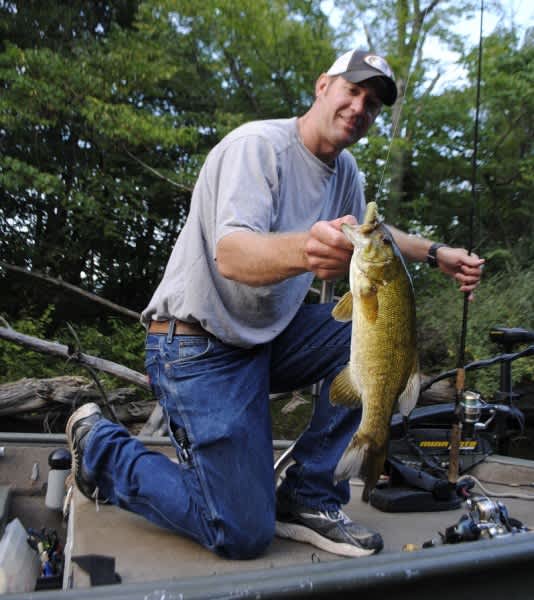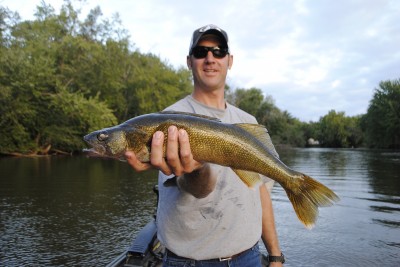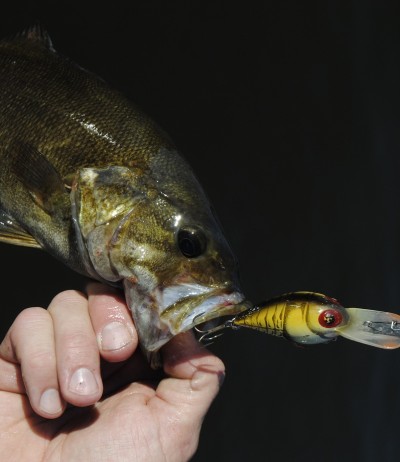High Waters and Plentiful Bass on the Kalamazoo River
Bob Gwizdz 10.08.14

On Scott Markham’s third cast, I heard the whoosh of his hook set and looked up to see his rod bent into a parabola.
“This is a good one,” he said.
I scrambled to grab the landing net, but the fish, a very sizable smallmouth bass, broke the surface and threw the bait back at Markham.
He was philosophical about it.
“The good ones are just starting to bite again,” he said. “For the last six weeks you could catch all the little ankle-biters you wanted, but the better fish were hard to come by. We’re getting back into some good fish again.”
Within a cast or two it was my turn. I was rolling a chartreuse tube along bottom in the current and could feel every pebble. When the bait stopped, I gave it a half-hearted flick of the wrist—just so I wouldn’t wedge it in the rock rubble—but it came alive. A nice smallmouth (I eyeballed it at about 2-1/2 pounds) came to the surface and spit the bait.

Moments later, Markham connected again, this time on a 12-incher.
Figures, eh? We’d jumped off two nice picture fish and when we stayed connected, it was with a squeaker.
But the nice-fish drought didn’t last long; I connected with a chunky smallie and this time, set the hook properly. Markham slid the landing net under it and hoisted it aboard. We slapped it on a measuring board just for the record: 18 inches.
Over the next 45 minutes we put four more fish in the boat, three of them better than the 14-inch keeper size for bass.
We were fishing on the Kalamazoo River just upstream of the city limits, downstream from Morrow Lake. It’s a stretch I’ve fished with Markham at least a half-dozen times over the course of the last decade and every trip has had this much in common: we always caught good numbers and usually caught some pretty good ones, too, which is not always the case on an urban stream.
But this excursion was shaping up to be better than most; four of our first six fish would keep and we jumped off two more keepers. “For the last few weeks it would have taken a week to do that,” Markham said.
I hadn’t had high hopes before we started as it had rained, hard, two days previous and the water was high and colored up (and that’s why we were using chartreuse tubes, Markham explained, as opposed to his usual pumpkin- or watermelon-hued baits). But Markham was more optimistic than I as the weather had turned positive to his way of thinking.
“Usually, after the first good cold snap comes through and it warms back up, that’s when the big fish start biting again,” he said. “Once you hit July or so, you catch plenty of fish, but the good ones are hard to come by. But once you start getting that cold weather, they know it’s time to strap on the feed bag.”

Our catch rate slowed and the size of the fish dropped, too. Then Markham hung a good one and when it didn’t come to the surface, I was sure it was pike as we often catch nice northerns on this stretch. I was wrong. As Markham brought the fish to the net, I spied a gorgeous, fat, golden-colored walleye. Markham posed for a picture and turned it loose.
Our drill was simple; Markham kept the nose of his 18-foot flat-bottomed aluminum boat pointed upstream and stayed on the trolling motor as we drifted downstream. We fished tubes and crankbaits (Markham a chartreuse Wiggle Wart, me a red-crawfish Little N) and caught equal numbers of bass on plugs and plastics. I fooled around with a Texas-rigged craw worm for a while and Markham fished with a topwater lure a bit, but it didn’t take many unproductive casts before we both went back to the crankbait/tube routine. Hey, if it ain’t broke.
In all, we fished a little less than four hours and boated around 30 bass, five or six of which were better than the 14-inch minimum size limit. While that’s fairly strong for an urban stream, it’s not unusual here on the Kalamazoo. Over the years Markham and I have caught plenty of three- to five-pounders—the best of which, when Markham weighed it on a hand-held digital scale, registered five pounds and nine ounces. I’ll bet he’s caught better ones when I wasn’t with him.
Markham, who’s been guiding on the Kalamazoo River for a dozen years now, offers relatively low-cost, five-hour fishing trips, which, during the summer months, are perfect for an evening after work. Now that the days are shortening, he’ll be doing most of his work on weekends.
To see what he has to offer, visit www.jumpinsmallie.com. I recommend him, highly.
For more information on Michigan fishing go to michigan.org. Click here to purchase a Michigan fishing license online.
This article was produced in partnership with Pure Michigan.

